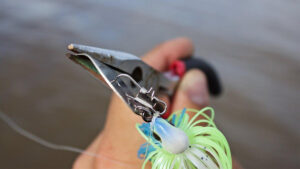The bladed jig—commonly referred to as a vibrating jigs or Chatterbait—has become a go-to bass fishing lures for anglers all around the country.
One major reason for this success is its versatility via modification. Bending the blade on any given vibrating jig is an excellent way to get more bites when the fishing is tough. It’s quick, easy, and works on every brand of bladed jig I’ve tried it on, be it a V&M Pacemaker Lightning Blade or the Z Man Project Z Chatterbait Chatterbait.
Why bend your blade?
By bending the tip of your vibrating jig blade, you are changing the amount of water displaced by your bladed jig throughout the retrieve. As you experiment with different angles on your blade you’ll see several small but noticeable changes in the action of your lure.
For one, your bait is going to thump more violently; so much so that you’ll be able to feel it on your first cast with the altered jig. In turn, this will raise your lure in the water column which allows you to reel your bait slower while keeping it in the preferred strike zone. ?
In other scenarios, I resort to angling a vibrating jig blade out of necessity. After bouncing a lure off of docks, dragging it through rocks and snagging it on underwater structure I’ve found bladed jigs can get out of tune. They’ll lose their hunting action and won’t give off the same thump as before. By bending your blade slightly you can remedy this issue and get your bait back to tracking true.
By arching your blade you’re simply changing the pulse of the lure underwater. The vibration the bait emits will undoubtedly be different than before and contrasting to what other anglers on your local fishery are using. Showing bass something slightly different can be key in getting a few extra bites throughout a day of fishing.
How to do it
The actual bending of your vibrating jigs’ blade is incredibly easy; you’ll just need a pair of pliers. Settle your pliers about 1/4 inch from the tip of the blade and firmly bend your blade downwards—away from the line tie—until the tip of the blade is at nearly a 45-degree angle.
The only tricky part is ensuring the crease of your bend is straight. What I mean by that is the entire tip of the blade that you bent is at the same angle across the entire blade. If you bend one corner of the blade more than the other it can ruin the swimming action of the lure, forcing the bait to kick one direction or the other.
Try bending your blade the next time you need to resurrect an old, beat-up vibrating jig or if you’re looking for a little extra thump out of your lure.
















